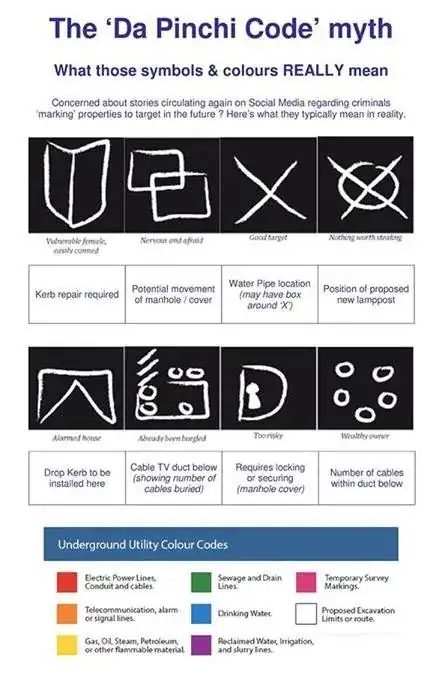This is not actually an answer to the question you asked. However, I hope you'll find it useful anyway, since it's quite hard to prove a negative.
According to this BBC News article "Da Pinchi codes' not for burglars, say police," the chalk signs referenced in the articles you linked to are used for innocent purposes. The source seems to be this "South Worcestershire Cops" Facebook post*, which says that the symbols are used by utility companies, and has a helpful (if unfortunately low-resolution) picture:

Another linked BBC News article, "What do those squiggles on the pavement actually mean?," has some more examples of utility road markings. It confirms the water pipe symbol (an "X") and the lamp-post symbol (a circle with an "X" in it), and describes similar symbols for cables. Unfortunately, I haven't found any independent confirmation of the meaning of the "kerb repair required," "potential movement of manhole/cover," and "drop kerb to be installed here" signs.
There is also a relevant Snopes article, "Grab and Go Code Chalkers", which gives the verdict "Unproven".
*The "South Worcestershire Cops" Facebook account seems to be legitimate, as the West Mercia Police have an officially verified Facebook account which links to one of its posts.
Other news sources that covered this story:
Other sources about road repair/utility street markings:
Some comments that appeared beneath the question that I thought were particularly relevant or interesting:
Those remind me of Hobo signs (symbols) – ChrisW Oct 15 '14 at 12:09
It's not clear to me why a burglar who has cased a house would want to share his information with competitors and/or law enforcement. – Nate Eldredge Oct 16 '14 at 17:37
This is just an anecdote so it's only a comment, but some friends of mine in London were repeatedly burgled without knowing (their lock could be forced without trace), and the police told them that burglars had left such a mark. However, unlike your claims: a) these marks changed frequently and the police struggled to keep up with them, b) they were unique to individual gangs and areas, not universal (for obvious reasons!), c) they were subtle, not obvious things that could wash away like chalk (I think theirs was a brick outside the driveway and a scratch in the woodwork near the weak lock) – user568458 Mar 9 '16 at 11:11
